Table Of Contents
Tilers Place is reader-supported. When you buy through links on this page, I may earn an affiliate commission on qualifying purchases.
The Multi-Tool Is The Best Grout Removal Tool – Here’s Why
Can a grout saw cut through metal, wood and plastic?
Can a grinder carefully sand the paint off crown moldings?
Can a reciprocating saw cleanly trim door casings?
!NO!
Now, what if I told you an Oscillating Multi-Tool can do ALL of those things and still tear through tile grout like a bullet through a tin can?
The multi-tool is the swiss army knife of the power tool world, the super versatile, always ready Mr Fix-It that can tackle anything, and it’s that versatility that makes it the best removing grout tool overall.
While it’s versatility is matched by the Dremel Rotary and it’s myriad of accessories, I find the grout removal attachments for the Dremel R.T wear out too fast for extended use – hence why it misses out on top spot.
This in-depth article will go delve into the oscillating mult-tool and prove why it’s the best investment you can make for your home or business and how it is unmatched in terms of versatility and of course – grout removal prowess.
Since the explosion of multi-tools on the market in 2009, I have been using these tools of wonder extensively in my tiling work and at home.
With a multi-tool in one hand and a selection of various blades in the other, I am always busy repairing, sanding and cutting whatever my wife needs doing around the home.
At work, I use my multi-tool extensively to cut door casings and drywall and of course, removing grout like a pro.
The Origins of the Oscillating Multi-Tool
Believe it or not, the multi-tool was around for decades before it seemingly exploded onto the market back in 2009.
German tool company, Fein, who has been pioneering and producing electric tools since it’s founding in 1867, turned it’s attention to the medical industry to solve a common problem:
How to remove a plaster cast without injuring the patient?
In 1967, the answer was found through the use of oscillation.
Instead of using the standard angle grinder that could easily tear through plaster and continue onwards towards human flesh, the oscillating tool would only work when it comes into contact with something very hard and solid.
It requires resistance to actually begin working, much like a car that has its wheels in the air. Without contact with the road, the tyres will spin endlessly but not push the car forward.
The new oscillating tool for removing plaster casts was a huge success and reduced patient injury to the occasional burn from the hot blade if the operator went in too deep.
A much better proposition over a deep gash in one’s arm or leg, that’s for sure.
After that, Fein worked with the automotive industry to develop the tool further and use it for removing windscreens held in place with silicone.
Fein held the patent for the oscillating technology until 2009, when their patent expired.
This opened the floodgates for every other power tool manufacturer to enter the market with their own versions of the oscillating multi-tool and provided the world with the most versatile tool ever.
That is the reason why the tool seemingly came out of nowhere and made such an impact on the market, as the door was opened for everyone to enter the competition.
Nearly ten years on and the oscillating multi-tool is continuously getting redeveloping and enhanced with more and higher quality blades available for every task imaginable.
For me, it couldn’t have come at a better time as the tiling market was seeing more and tile, grout repair work and the tools of old were not up to the sheer scale that I was seeing.
It was the begining of a new era for tilers and contractors all over the world.
Why The Multi-Tool Is the Best Grout Removal Tool
Here I will go into the aspect you will be most interested in.
I know you came here looking for the best way to remove grout from tiles, mosaics and natural stone and so I want to tell you why the multi-tool is the best tool for removing grout.
In case you haven’t caught on my main theme of this article, I’ll tell you.
The main reason why the oscillating multi-tool is the best grout remover is that of its versatility.
It’s not a one-off expenditure like a grout saw or any specialized grout removal tool that will be redundant for any other job you need to do around the home or job site.
Nowadays, everyone is budget conscious and that is one of the reasons why lot’s of people are turning to DIY to get things done. We simply cannot afford to hire a professional to do every single job around the home.
Granted there are some things we should never touch if we ain’t qualified for them (plumbing and electrical being a prudent one to avoid), there are still there are plenty of things we can do.
Removing old grout and repairing grout or tiles being one of them.
Now if you were to tackle a grout repair project, you’d jump on google and some site would recommend you use a grout saw or a Dremel rotary tool. You would even run into some joker telling you to use a hammer and screwdriver to chisel the old grout out.
Of course, your common sense would prevail and you would avoid anything else he said cause that is downright the worst way to remove grout ever and it should be wiped from the internet forever…but I digress.
Yes the grout saw is a great tool for removing grout and I do recommend it, it’s got a carbide coated tip that can bite into the grout and effectively grind it to dust.
I’ve been using them for many years.
However, they are slow, require a lot of effort on your part and they only have ONE use!
Grout removal.
So, while they are great tools for removing grout, they are not by any means the very best grout removers. This is where the oscillating multi-tool with a grout removal blade steps in.
All the other tools get down on their knees, look at the floor and yell as one:
“ALL HAIL THE KING!”
The way the oscillating multi-tool won its reputation as the best grout removal tool is because it’s simply awesome at removing grout.
• Ease of Use
• Variable Speed
• Low amount of airborne dust
• Can fit into tight spaces
• Won’t tear into substrate
• Does all the work for you
• Very quick at removing grout.
• Can choose between cordless or corded variants.
After I’m done removing grout, I can switch out the blade and go remove some paint from a windowsill I’m preparing for paint.
I can cut sheets of metal into lengths for the old shed I’m repairing or scrape the old lino off the floor where I’m prepping it for tiling.
The range of applications this multi-tool can be applied to only increase with use.
Over time you’ll realize you are reaching for it more and more as with the correct blade you’ll be able to do most things a lot quicker than conventional hand or power tools.
And that is why it is the best tool for removing grout.
It’s not limited to just one use like all the others are.
Yes, it rocks at removing grout due to its inherent design, but it can also be used for so many other uses.
That is why it’s the best grout removal tool and the best investment you can make for your home or business.
If you are finally convinced you need an oscillating multi-tool to complete your tool-kit, follow this link to browse the great selection of multi-tools available.
Find one that will suit your budget or get the brand that you own the corresponding battery packs for.
Got a Makita Cordless Drill?
Great!
Then grab a Makita XMT035 Multi-tool.
All your old batteries will slip right into this new bad boy and you’ll be ready to rip into any grout or home projects you got lying around waiting.
Large retailers like Home Depot or Amazon sell a lot of cheap combos like this one where you get the multi-tool, a battery pack, charger and a handy tool case to carry it in.
All for a fraction of what all the items would cost you separately.
You may have a brand your loyal to or own a heap of batteries that you might like to use. In that case it’d be wise to just purchase that brand name. Any hardware sells a large variety of multi-tools and you will surely find the one you need.
Remember, all the multi-tools follow the same premise so they will perform the same.
It’s the price that will indicate whether their a tool for a professional or a casual DIY-er that will only use it on occasion.
Buy an oscillating multi-tool to fit your budget and requirements.
If you are not ready to make a decision, click here to read my oscillating multi-tool buyers guide.
It will provide you with pointers on which multi-tool will be right for you and which brands make the best tool for removing grout, as not all brands will fit the bill.
Can’t choose which is the best one?
Keep reading.
Instead of making you review every single oscillating multi-tool available at for sale, I can tell you the best one right away.
The Best Oscillating Multi-Tool For Removing Grout
In my personal opinion, the best oscillating multi-tool for removing grout is the Dewalt DCS355D1. If you don’t like Dewalt power tools, feel free to stop reading here.
Here’s my review of the oscillating multi-tool.
The reason I believe the Dewalt DCS355D1 is the best of all the oscillating multi-tools and fits the bill as the greatest electric tool for removing grout is judged on a number of criteria.
The first being, does it come from a reliable brand name?
I can firmly confirm that yes, DeWalt is definitely a reliable brand name and one of the best-known power tool manufacturers around.
After being purchased by Stanley Black and Decker, it has become a household name and it’s instantly recognizable bumble-bee coloring makes it a common tool on building sites the world over.
I have owned countless DeWalt tools over the years and have always been impressed by their build quality, ergonomics and ability to work as hard as I do. I can confirm that their build quality and design has carried over to their cordless oscillating multi-tool as well.
The DCS355D1 also benefits from DeWalt’s XR System.
Any tool bearing the XR in their name means that they are a brushless tool. This is a massive advantage as you will not need to worry about buying new brushes for the multi-tool and taking it apart for maintenance.
This is a big, big win for you and ensures you save money in the long run.
Another important factor in choosing the DeWalt DCS355D1 as the best grout removal tool was, could it fit a grout removal blade?
A quick browse online confirmed that it came with a variety of grout removal blades for every situation.
DeWalt manufactures a wide range of different grout removal blades to ensure you can fit your multi-tool into every nook and cranny.
The most important area being right up against a wall.
For areas like that, you need a narrow blade that ensures you can remove all the grout on a floor or against 90 degree angles.
You can also fit blades from other manufacturers as well which is a massive bonus.
Do note however that not all have the quick release type heads so you will need to remove the locking head with an allen key like traditional oscillating multi-tools.
If you want to read which grout removal blades you will require to make the very best tool for removing grout, I prepared a handy guide for you here.
As always I have hunted down the lowest prices on the net for your convenience.
And yes of course, you can also buy a whole range of other blades for cutting every type of common material, for sanding paint and veneer and for scraping.
I like this kit you can purchase that provides you with a nice assortment of blades to get you started, chances are they’ll be all you need for anything around the home.
It also comes with a 2AH battery, a charger and a convenient carry case to make you a real pro.
Just remember to buy the grout removal blades as they are a specialist blade and are not included in the kit.
Other things that I like about the DeWalt DCS355D1 are the inclusion of a handy L.E.D light at the head of the multi-tool.
This helps a great deal in dark bathrooms or when I’m working in a tight shower and my body is blocking out all the light. Instead of having to work with a headlamp or running a power cord and lamp in, I can work with the light of the L.E.D alone.
Since it is a battery powered tile grout remover, I do not need to worry about running any power cords around the site at all. This is a massive bonus as it saves time and removes a dangerous tripping hazard. It has also saved me on remote sites that didn’t have power hooked up yet.
Just slap in a battery and your good to go!
This leads me to the subject of the batteries themselves.
As the DCS355D1 is cordless, it is imperative the batteries do not affect the performance or running time of the tool. As we know, downtime on the work site or when we have limited time at home to get things done is a major pain in the butt.
Thankfully DeWalt is a quality brand and knows a thing or two about batteries.
In layman’s terms, the bigger the number, the longer your tool will run for.
I have a whole range of batteries but I always slap a 5AH battery into my multi-tool and it ensures I get a whole days running time for various tasks.
If you’ll be doing a lot of grout removal, I highly recommend you buy the new 6AH battery.
It’s a true powerhouse of a battery and for the amount of freedom it grants you, the price is very competitive.
At the time of writing, I just put an order through for two 6AH batteries and I can’t wait to give them a thorough thrashing.
I can’t believe how long the 5AH battery lasts, so this one will be even more incredible, of that I’m certain.
Here’s a link to the Amazon listing that I purchased them from.
The DeWalt DCS355D1 also have a variable speed trigger in lieu of a standard rotary dial like other oscillating multi-tools.
This makes setting the speed super easy.
With the mere applying of pressure, you can go from 0-20,000 oscillations per minute at any time without having to stop and adjusting the dial. My old Bosch multi-tool had the dial and it made adjusting the speed on the fly impossible!
Now when I begin a cut I can squeeze gently to allow the blade to bite into the material, once I got a nice groove cut out, I can set maximum revs and power my way through.
Do you want to know the best part about all of these features?
They’re affordable!
DeWalt has priced their multi-tool much lower than other competitors and with some selling for over $500, at a couple hundred bucks, the DeWalt DCS355D1 is an absolute steal.
Okay, I believe that is enough talk of the DCS355D1, I believe you know enough now to make an informed decision about which oscillating multi-tool to buy.
End of the day, I love my DeWalt and it’s made my job a whole lot easier doing tasks which used to be tedious and added more than a few grey hairs to my beard.
Carl’s Suggested Shopping List
I understand you may have been left confused with all the options I presented you and have no idea what to buy.
Here is my suggested shopping cart to ensure you get the best tool for removing grout and a versatile oscillating multi-tool.
I hunted down the cheapest prices and provided the links, all you need to do is click on them.
You will receive a 2Ah battery, charger, a wide selection of accessories blades and a carry bag to fit it all in.
2. A Larger Battery.
If you want the most out of your new DeWalt multi-tool, I would highly recommend you purchase this battery.
It is the highest capacity battery DeWalt produces and it will ensure your investment runs stronger for longer.
You will get more done on a single charge than the standard battery would on 2 or 3.
DeWalts finest grout removal blade, purpose-built for quick grout removal.
It supports the quick change blade mechanism on the DCS355D1 and works wonders on all types of grout.
It has a unique blade design that makes it tear through grout quicker than regular blades.
It is highly affordable for a specialist blade and a must have.
This will do the bulk of the grout removing due to its large surface diameter.
4. DeWalt DWA4242 Diamond Flush Cut Blade.
This will be your go-to blade for narrow areas, it will go to all the places your Fast Cut blade can’t.
The flush design ensures you can remove floor grout right up against a wall or in any tight areas.
Trust me, you will definitely need one of these in your grout removal kit.
I use it to finish up any grout that I can’t access with the round blade and it’s saved my butt numerous times.
Conclusion
Since it’s conception in 1967 by Fein, the oscillating multi-tool has been revolutionizing the powered cutting tool market with a whole new way of cutting hard materials.
After Fein’s patent expired in 2009, the whole world experienced an oscillating power tool boom with all major power tool companies bringing their own versions to the market.
Fast forward a decade and power tool giant DeWalt has brought us the most versatile and affordable oscillating power tool.
With great ergonomics, build quality and most importantly; a competitive price. The DeWalt DCS355D1 is a blessing to all handypeople everywhere.
On top of all that, it is also the very best tool for removing grout when coupled with a DeWalt grout removal blade.
I covered the highlights of the multi-tool in my DeWalt multi-tool review and provided a buyers list of what to buy so that anyone can also get their hands on this great system.
Eager to start your first project?
Check out my guide to removing grout with an oscillating tool.
Further Reading.
If you wish to further your knowledge and understand grout like a grizzled veteran of the trade, I have written extensively about grout removal tools and repairing grout. Just use the search bar above to find everything you need.
Enjoyed this article, found it helpful?
Please consider giving it a share on your social networks so others can learn as well.
Tile grout is a common problem in households everywhere and this site provides the best advice for free.

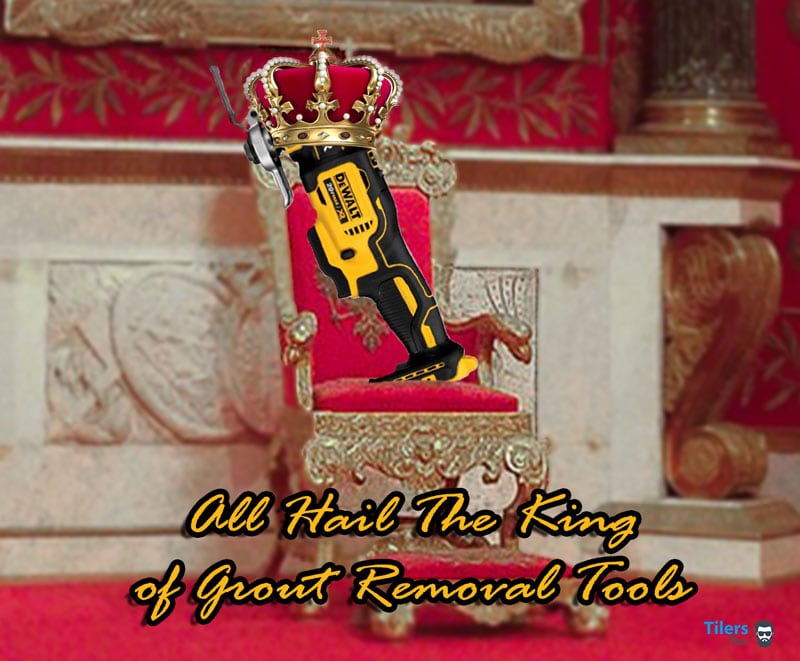

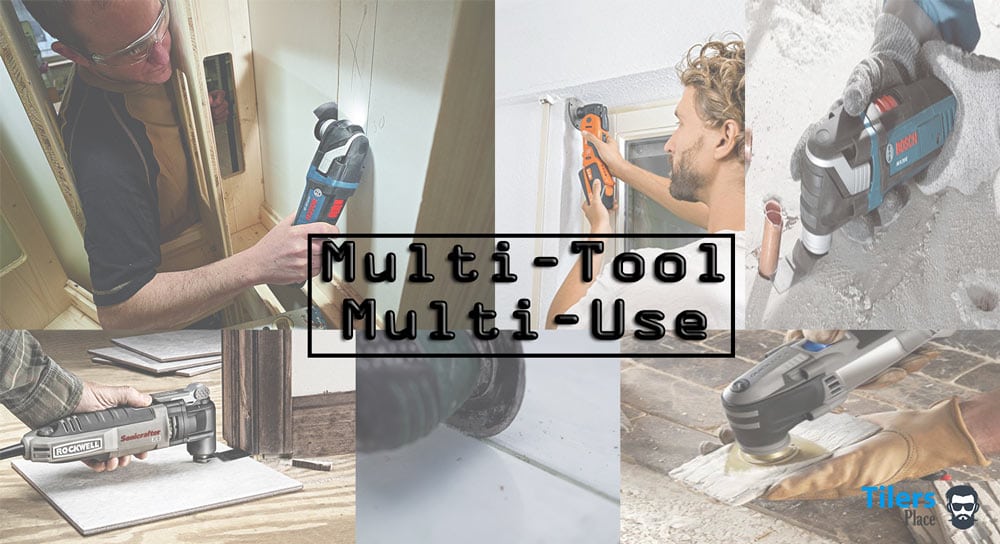

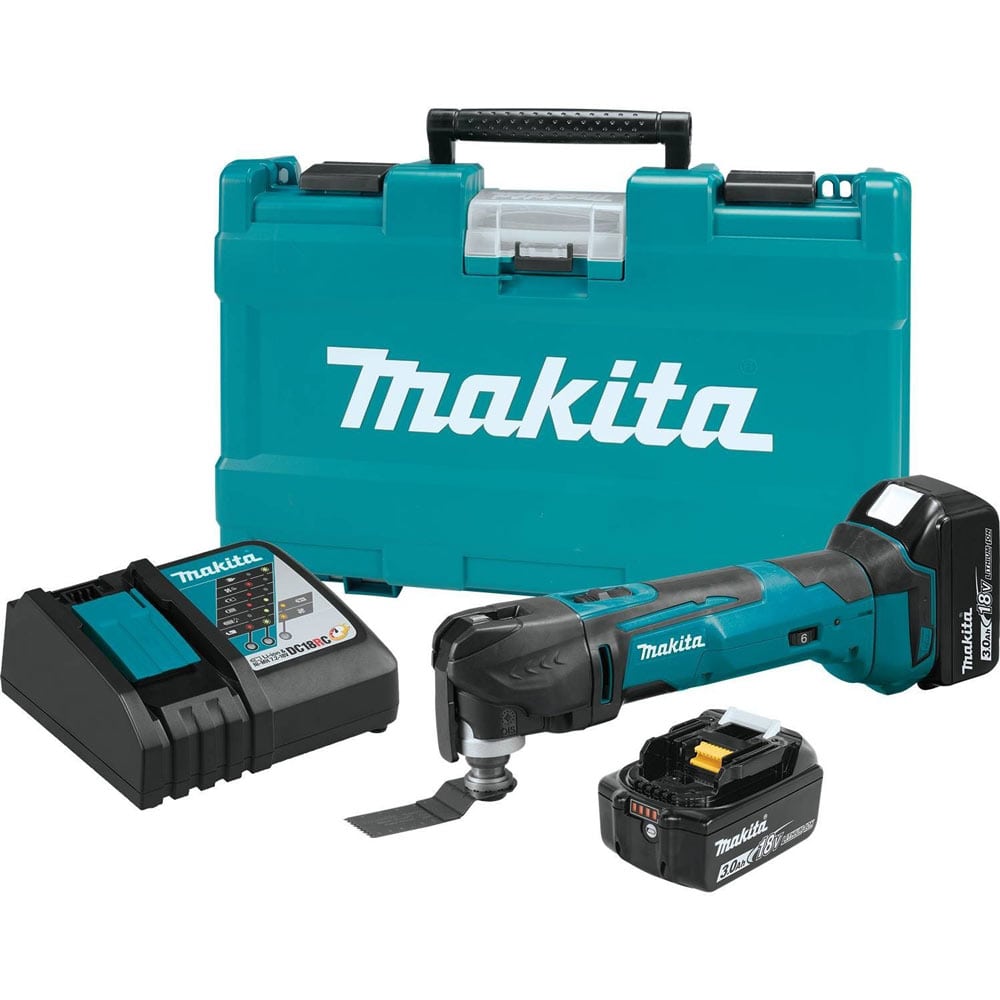
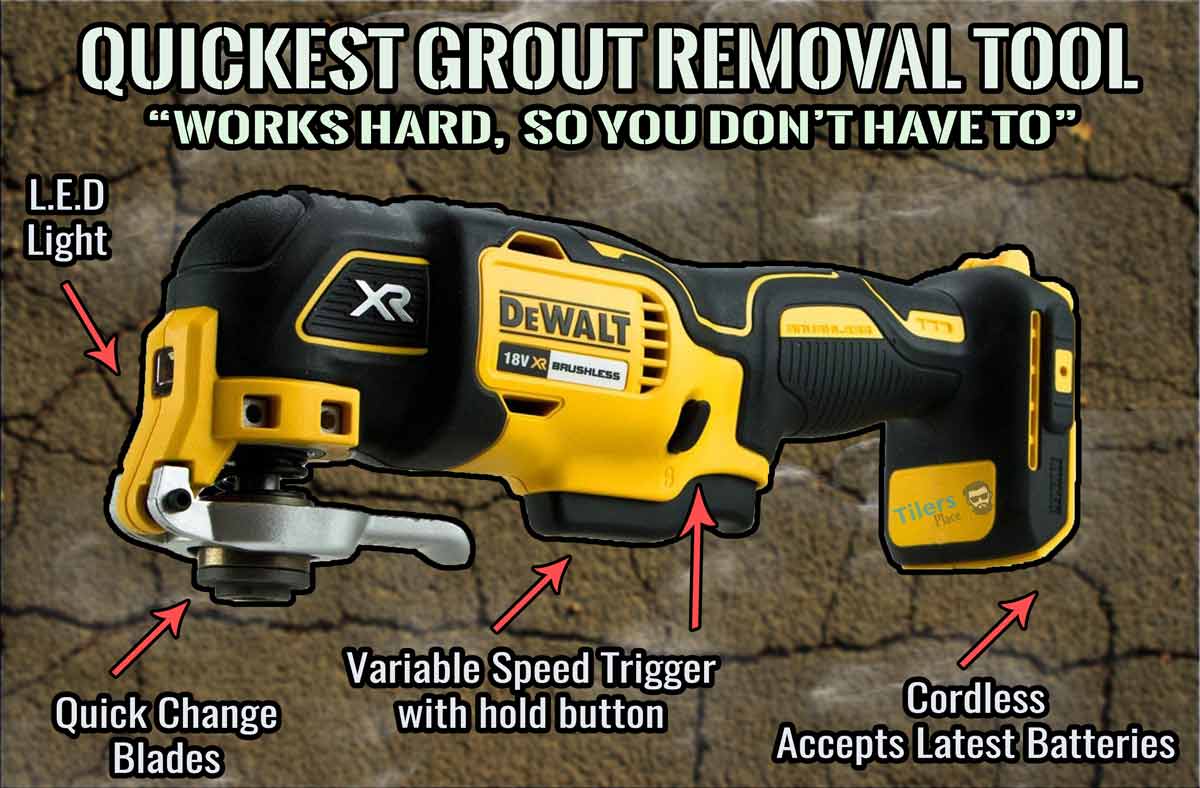

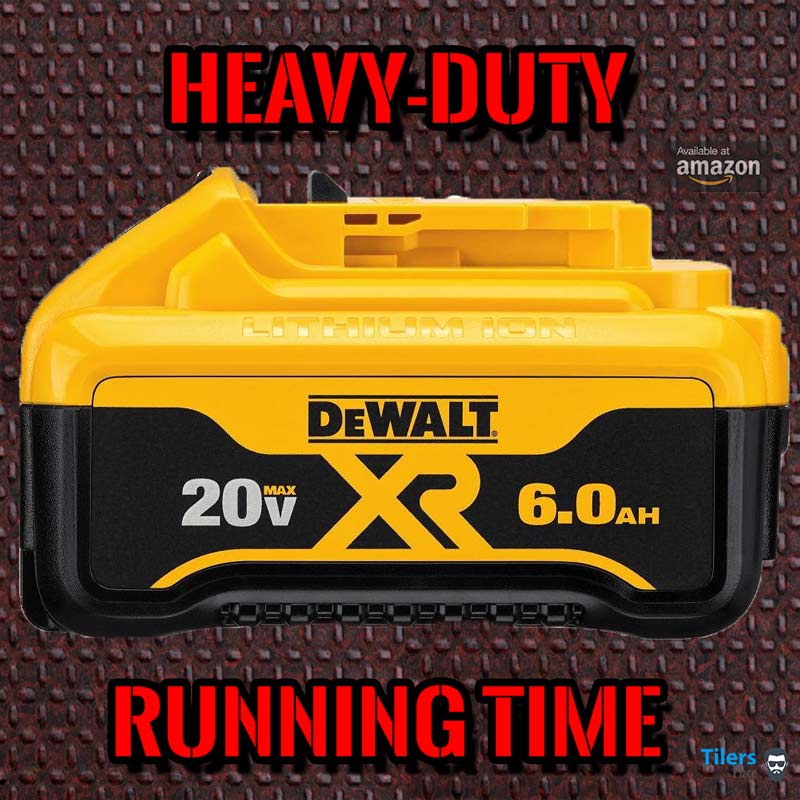






Thanks Carl, you just provoked a massive Amazon shopping trip XD I literally BROUGHT EVERYTHING on your suggested shopping list XD XD XD I thought what the hell, this guy obviously lives and breathes grout removal stuff, I might as well get what he recommends. My wife and I recently purchased our first house we plan on flipping and the grout in it is terrible. I think these new toys should sort that problem out.
Great write-up Carl, you have been convinced to get a multi-tool. The dewalts look good to me, Im just not sure whether to go cordless or corded? Any tips to help make up my mind? thanx!
“Can a Dremel trim door casings or cut holes in drywall?
!NO!”
Au contraire!!!
The Drexel Multi-Max can do everything that any of your multi-tools can do. Yes, it too is a multi-tool, but it is a Dremel. Being a multi-tool, it can do anything that any other multi tool can, including trim door casings and cut holes in drywall… which is what you said a Dremel could not do.
OK, I realize that you were referring to the standard rotary type of Dremels, which are what most people think of when the name Dremel is mentioned, but… I just couldn’t resist responding.
That being said, a standard drill type Dremel CAN cut a hole in sheetrock if you use the correct attachments and bits. They even make a kit for grout removal. (https://www.dremel.com/en_US/tools/-/subcategory/attachment/find-by-category/37802/rotary)
Thanks for the constructive comment Don!
I stand corrected, I didn’t realize the Dremel rotary tool comes with such a wide variety of accessories now. It’s 2019 now so what better time to go over this article and revise it with your feedback taken on board.
Thanks for visiting and providing informative feedback 🙂
Excellent article. I didn’t know the history of the multi tool. I don’t think he’s referring to a Dremel rotary. They make their own multi tool. I have the 3.5 amp corded which is under $100. I think the DeWalt you recommended is a better choice if you plan on using it a lot, but the Dremel is great for occasional use.